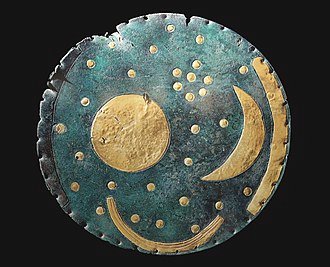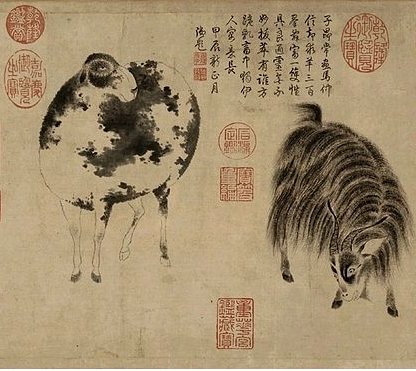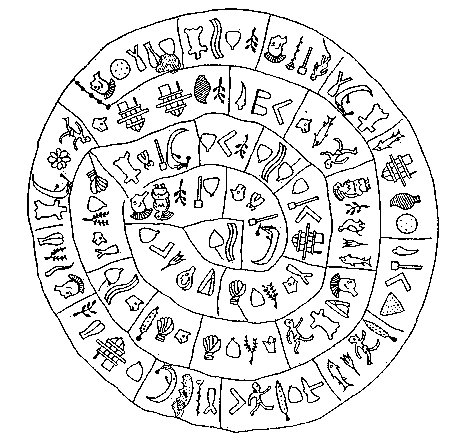10-10. Now, once again, a TV-program has given me pieces to the great puzzle, because it was said that around 1600 BC (i.e. approximately at the same time as the Phaistos disc I thought) the famous Nebra disc had been created:
First of all the conspicious 7 star formation high up on the disc suggests to me that the Phaistos cicular sign with 6 + 1 dots inside might also be referring to the Rainy Pleiades cluster of stars (Tau-ono + Alcyone): Tautoru. The Belt of Orion. Van Tilburg. Mgv.: 1. Toutoru, Orion's belt. Mq.: tautou, a constellation of three stars. 2. Toutoru. hung by threes. Mq.: tautou, id. Churchill. Ono. Six. Tauono. 'Six stones' = Pleiades = Matariki. Van Tilburg. ... Now the deluge was caused by the male waters from the sky meeting the female waters which issued forth from the ground. The holes in the sky by which the upper waters escaped were made by God when he removed stars out of the constellation of the Pleiades; and in order to stop this torrent of rain, God had afterwards to bung up the two holes with a couple of stars borrowed from the constellation of the Bear. That is why the Bear runs after the Pleiades to this day; she wants her children back, but she will never get them till after the Last Day ... Instead of small circles of golden star lights the dots might illustrate dark holes for the escape of waters, I thought, remembering how exactly the same design (with 6 + 1 holes) had been chosen on the metal caps for outlet of water from my bath tub. → Golden light resources in the night contrasted with watery escape holes in daytime.
Here below I have summarized in a table my guesses as to the basic meanings of the signs on the Phaistos disc. I have decided to change from Prince to Princess for my type number 9, mainly because this youngster's head has no beard:
... Whatever may have been the reason for the preėminence of the Pleiades cluster - and it was probably a combination of several reasons - it is certain that when men became increasingly alert ot the annual cycles of celestial phenomena, the changing altitudes and azimuths of the Sun, the lengthening and shortening of days and the corresponding variation in temperature, the slow march of the constellations across the sky, and realized the need of choosing a day on which to begin the yearly cycle of the calendar, they turned to the Pleiades for guidance. Undoubtedly the Polynesians carried the Pleiades year with them into the Pacific from the ancient homeland ... With but few exceptions they continued to date the annual cycle from the rising of these stars until modern times. In the Hawaiian, Samoan, Tongan, Society, Marquesan, and some other islands the new year began in late November or early December with the first new Moon after the first appearance of the Pleiades in the eastern sky in the evening twilight. Notable exceptions to the general rule are found in Pukapuka and among certain tribes of New Zealand where the new year was inaugurated by the first new Moon after the Pleiades appeared on the eastern horizon just before sunrise in June. Traces of an ancient year beginning in May have been noted in the Society Islands, but there is some uncertainty about the beginning of the year in native annals generally, at least as reported by missionaries and others, due perhaps to the desire to make the Polynesian months coincide with the stated months of the modern calendar ... The ancient year was usually divided in two parts as defined from the Pleiades: Nika. 'Savage tribes knew the Pleiades familiarly, as well as did the people of ancient and modern civilization; and Ellis wrote of the natives of the Society and Tonga Islands, who called these stars Matarii, the Little Eyes: The two seasons of the year were divided by the Pleiades; the first, Matarii i nia, the Pleiades Above, commenced when, in the evening, those stars appeared on the horizon, and continued while, after sunset, they were above. The other season, Matarii i raro, the Pleiades Below, began when, at sunset, they ceased to be visible, and continued till, in the evening, they appeared again above the horizon. Gill gives a similar story from the Hervey group, where the Little Eyes are Matariki, and at one time but a single star, so bright that their god Tane in envy got hold of Aumea, our Aldebaran, and, accompanied by Mere, our Sirius, chased the offender, who took refuge in a stream. Mere, however, drained off the water, and Tane hurled Aumea at the fugitive, breaking him into the six pieces that we now see, whence the native name for the fragments, Tauono, the Six, quoted by Flammarion as Tau, both titles singularly like the Latin Taurus. They were the favorite one of the various avelas, or guides at sea in night voyages from one island to another; and, as opening the year, objects of worship down to 1857, when Christianity prevailed throughout these islands.' (Allen) The idea of the Pleiades visible above could be the reason for why my Phaistos type number 2 is conspiciously located above my type number 9 at a special place on the disc, viz. at position number 11 ('one more') on the top (above) side:
A quick look at the bottom of the Phaistos disc then reveals how type number 2 is to be found only in two places:
This indicates for me that the bottom of the Phaistos disc could have illustrated Matariki i raro in contrast to Matariki i nika for the top surface. As a kind of confirmation we can see the binome constituted by 2 and 31 in department 26 on the bottom side:
When the Pleiades were below (i raro) it meant they were invisible due to their location below the horizon (i.e. they were inside Mother Earth, Pacha-mama, so to say).
|
||||||||||||||||||||||||||||||||||||||||||||||||||||||||||||||||||||||||||||||||||||||||||||||||||||||||||||||||||||||||||||||||||||||||||||||||||||||||||||||||||||||||||||||||||||||||||||||||||||||||||||||||||||||||||||||||||||||||||||||||||||||||||||||||||||||||||||||||||||||||||||||||||||||||||||||||||||||||||||||||||||||||||||||||||||||||||||||||||||||||||||||||||||||||||||||||||||||||||||||||||||||||||||||||||||||||||||||








